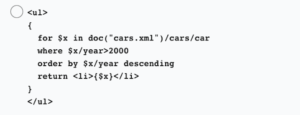
xml linkedin assessment answers
1. Which element in this XML code is not a good candidate for conversion into an attribute?

- <birthplace>
- <name>
- <alias>
- <power>
2. A markup language is a _____ -readable language that ______ that the computer can ______ that text.
- processor; compiles; process
- non; processes; format
- human; annotates; manipulate
- system; stores; retrieve
3. When working with Ajax applications, which is faster, XML or JSON?
- JSON, because it transfers data without waiting for a server response
- XML, because it supports namespaces
- XML, because it is extensible
- JSON, because it is already parsed into a JavaScript object
4. Which type of DTD declaration is this code an example of?
- structured
- internal
- external
- linked
5. In the XML DOM, which property is best to use to loop through each of the nodes in the code snippet below?

- nextsibling
- nodeValue
- nodeName
- nextChild
6. You are working with the following XML code snippet. What do you need to include in your XSLT code to display Mercedes, Cadillac, Ford?

- <xsl: sort select=”model” />
- <xsl: sort select=”car” />
- <xsl: sort select=”make” />
- <xsl: sort select=”price” />
7. Which DOM node type may NOT have the EntityReference node type as one of its child nodes?
- Document
- EntityReference
- Element
- DocumentFragment
8. In an XML DD ATTLIST declaration, which default value is used to indicate that the attribute does not have to be included?
- #FIXED
- #OPTIONAL
- #DEFAULT
- #IMPLIED
9. You are working with this XML code snippet from the XML document cars.xml. You need to return the information about the cars built after the year 2000, as an ordered list, starting with the most recent. What does your XQuery look like?

10. What is not one of the advantages of the XML DOM?
- The XML DOM is language and platform independent.
- The XML DOM is efficient with memory and operational speed.
- The XML DOM is easy to navigate around to find specific information.
- The XML DOM is modifiable and dynamic.
11. The element is used to replace a namespace in the style sheet with a different namespace in the output Which XSLT element needs to be its parent node?
- any valid element
- root element
- top-level element in the corresponding namespace
- <xsl: namespace>
12. You are working with an XML document that uses an XML schema. How can you extend the document with elements not specified by the schema?
- Specify the new elements in the schema.
- Use the <any> element.
- Use <xs: extension>.
- Use the <redefine> element.
13. The element contains rules to apply when a specified node is matched. What are the rules for the attributes of this element?
- Attributes “mode” and “priority” are optional; “name” and “match” are required.
- Attributes “match,” “mode,” and “priority” are optional; “name” is required.
- Attributes “name ” “match,” mode” and “priority” are all optional.
- Attributes “mode” and “priority” are optional; either “name” or “match” must be present.
14. What characters do the five default entities in XML produce?
- ?. !, =, ‘, “
- <, >, &, “, ‘
- -. _, !=, \\, ^$
- &&, ||, <>, ==, !=
15. You need to use an angle bracket (<) inside an XML element. How do you do that?
- Enclose it within a code> PCDATA block.
- Precede it with a backslash (\).
- Enclose it in double quotes (“).
- Enclose it within a CDATA block.





